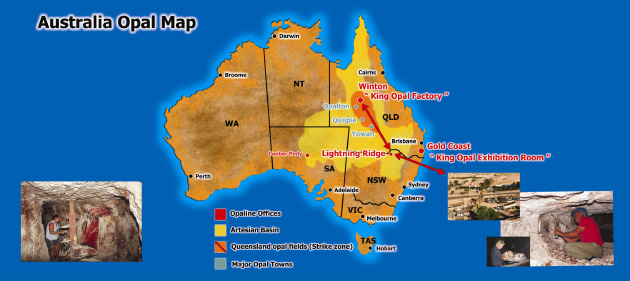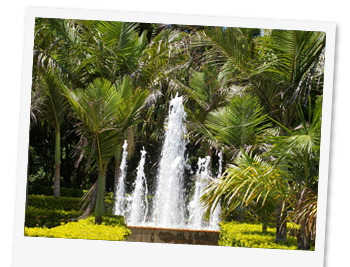
Australia is the world's greatest producer of precious opal. Over 90 per cent of the world's commercial opal comes from the desolate outback. All of the significant opal deposits in Australia are located within the Great Artesian Basin or close to it. The places where opal has been mined over the past 100 years are located here. The most important deposits are found in New South Wales, South Australia and Queensland.
Today, the mining is carried out at the following main areas and each produce solid opal with specific characteristics and colour patterns.
Central Queensland
The discovery of opal was reported in many areas however, the real development of Queensland's vast opal deposits began in 1873 with the discovery of fine quality opal north of Thargomindah. Within two years there had been many exciting finds throughout south western Queensland.
The Queensland fields are spread across 1,000km and produce almost all the world 's supply of boulder opal. This opal is produced from scattered locations in the vicinity of Yowah, Eromanga, Quilpie, Jundah, Opalton and Winton.
Almost all the opal is won by open cutting. Large and small ironstone boulders are split in the search for that illusive opal vein.
Lightning Ridge
Black opal was first discovered at Lighting Ridge in the late 1880s however, its commercial value was not at first recognised by buyers. Mining actually commenced in the early 1900s when some opal nobbies were found and trial shafts erected.
Opal occurs at Lightning Ridge either as 'nobbies', or in seams and thin layers within vertical or horizontal joint plains, in a soft greyish claystone that hardens and whitens on drying. This claystone is commonly referred to as 'opal dirt'. The opal dirt levels occur between 6 and 18 metres from the surface, but have been known to go as deep as 30 metres.
White Cliffs
Commercial mining commenced in the late 1880's at the White Cliffs Field in New South Wales. The opal mined here excited the world and the town soon developed, by the 1920's had a population of more than 3,000. White Cliffs produced fine quality seam material in such volumes the world had not previously seen. Sadly, the main run was worked out by 1930 and the field all but died out.
Andamooka
Andamooka is in the harsh desert and located near the edge of Lake Eyre. It was discovered in 1935 and is famous for producing brilliant crystal seam opal. It reached its peak in the 1960's when the population reached 3,000. Unfortunately this field is worked out with very little commercial production since the 1970's. Today much of Andamooka's population is employed at the nearby uranium mines of Roxby Downs.
Coober Pedy
Coober Pedy was discovered in 1915. This is where the world’s light seam opals are mined. Mining extended over an area 50 kilometres long, running approximately north south.
Today, the opal fields encompass an area of approximately 45 kilometres. The opal level is formed of soft pinkish clay mixed with soft bleached sandstone.
Mintabie
The fortunes of Mintabie came and went within a decade. In 1978 a group from Coober Pedy found nice quality black opal. Within a few years the population grew to 1500. Large powerful equipment was needed to rip the hard sandstone. More than 75 large bulldozers and many scrapers, excavators, etc quickly mined out this very rich outcrop. Mintabie produced fine quality light and black seam opal. This material was extremely hard, some able to scratch agate! Today there is only very limited mining activity.

Opal Association Member
The Opal Association is based in Australia and has industry members from around the world. It is administered by an executive committee that meets quarterly. The Association has subsequently attracted a diverse membership of opal miners, cutters, manufacturers, wholesalers and retailers of many year experience.





